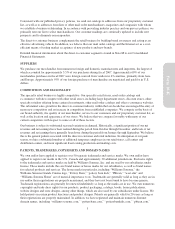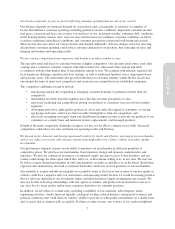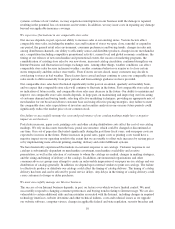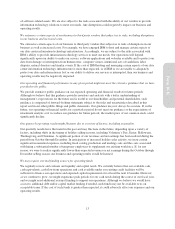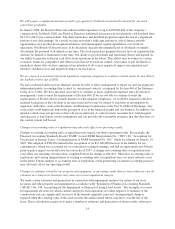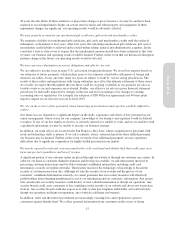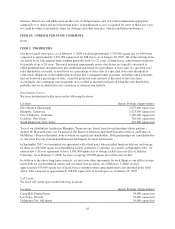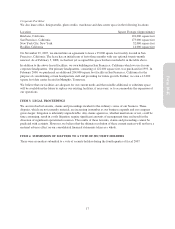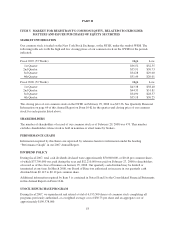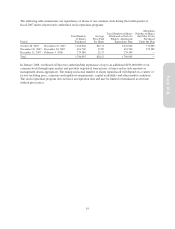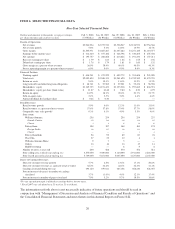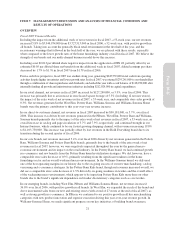Pottery Barn 2007 Annual Report Download - page 24
Download and view the complete annual report
Please find page 24 of the 2007 Pottery Barn annual report below. You can navigate through the pages in the report by either clicking on the pages listed below, or by using the keyword search tool below to find specific information within the annual report.We will require a significant amount of cash to pay quarterly dividends at intended levels and for our stock
repurchase programs.
In January 2008, the Board of Directors authorized the repurchase of up to $150,000,000 of the company’s
common stock. In March 2008, our Board of Directors authorized an increase in our quarterly cash dividend from
$0.115 to $0.12 per common share. The share repurchase and dividend programs require the use of a significant
portion of our cash earnings. As a result, we may not retain a sufficient amount of cash to finance growth
opportunities, new product development initiatives and unanticipated capital expenditures or to fund our
operations. Our Board of Directors may, at its discretion, decrease the intended level of dividends or entirely
discontinue the payment of dividends at any time. The stock repurchase program does not have an expiration date
and may be limited or terminated at any time. Our ability to pay dividends and repurchase shares will depend on
our ability to generate sufficient cash flows from operations in the future.This ability may be subject to certain
economic, financial, competitive and other factors that are beyond our control. Any failure to pay dividends or
repurchase shares after we have announced our intention to do so may negatively impact our reputation and
investor confidence in us and negatively impact our stock price.
We are exposed to potential risks from legislation requiring companies to evaluate controls under Section 404 of
the Sarbanes-Oxley Act of 2002.
We have evaluated and tested our internal controls in order to allow management to report on, and our registered
independent public accounting firm to attest to, our internal controls, as required by Section 404 of the Sarbanes-
Oxley Act of 2002. We have incurred, and expect to continue to incur, significant expenses and a diversion of
management’s time to meet the requirements of Section 404. If we are not able to continue to meet the
requirements of Section 404 in a timely manner or with adequate compliance, we would be required to disclose
material weaknesses if they develop or are uncovered and we may be subject to sanctions or investigation by
regulatory authorities, such as the Securities and Exchange Commission or the New York Stock Exchange. Any
such action could negatively impact the perception of us in the financial market and our business. In addition, our
internal controls may not prevent or detect all errors and fraud. A control system, no matter how well designed
and operated, is based upon certain assumptions and can provide only reasonable assurance that the objectives of
the control system will be met.
Changes to accounting rules or regulations may adversely affect our operating results.
Changes to existing accounting rules or regulations may impact our future operating results. For example, the
Financial Accounting Standards Board (“FASB”) issued FASB Interpretation No. (“FIN”) 48, “Accounting for
Uncertainty in Income Taxes—an interpretation of FASB Statement No. 109,” which we adopted on January 29,
2007. The adoption of FIN 48 resulted in the recognition of an $11,684,000 increase in the liability for tax
contingencies, which was accounted for as a reduction to retained earnings, and had an approximate net 40 basis
point negative impact on our effective tax rate in fiscal 2007. A change in accounting rules or regulations may
even affect our reporting of transactions completed before the change is effective. Other new accounting rules or
regulations and varying interpretations of existing accounting rules or regulations have occurred and may occur
in the future. Future changes to accounting rules or regulations or the questioning of current accounting practices
may adversely affect our operating results.
Changes to estimates related to our property and equipment, or operating results that are lower than our current
estimates at certain store locations, may cause us to incur impairment charges.
We make certain estimates and projections in connection with impairment analyses for certain of our store
locations and other property and equipment in accordance with “Statement of Financial Accounting Standards
(“SFAS”) No. 144, Accounting for the Impairment or Disposal of Long-Lived Assets.” For example, we review
for impairment all stores for which current cash flows from operations are either negative or nominal, or the
construction costs are significantly in excess of the amount originally expected. An impairment charge is
required when the carrying value of the asset exceeds the undiscounted future cash flows over the life of the
lease. These calculations require us to make a number of estimates and projections of future results, often up to
14



